Oct . 02, 2024 03:16 Back to list
Measuring the Micron Size of Custom Kiwi Fruit Pollen Particles
Exploring the Micron Size of Custom Kiwi Fruit Pollen
Kiwi fruit, scientifically known as Actinidia deliciosa, is a delicious and nutritious fruit that has gained significant popularity around the globe. Known for its vibrant green color and sweet-tart flavor, kiwi has not only become a favorite among consumers but also a subject of various agricultural studies aimed at improving its cultivation. One particular area that merits attention is the study of kiwi fruit pollen, especially its size measured in microns.
Pollen is a fine powder consisting of microscopic grains that are released by plants during the reproductive process. It plays a critical role in the fertilization of flowering plants and can vary greatly in size depending on the species. In the case of kiwi fruit, understanding the size of its pollen grains can greatly influence both the methods of pollination and the overall yield of the fruit.
What Are Microns?
A micron, or micrometer, is a unit of length in the metric system that equals one-millionth of a meter. To put it into perspective, a human hair measures approximately 70 to 100 microns in diameter. When we consider the size of kiwi pollen, it is crucial to note how these tiny particles interact not only with the plant’s reproductive structures but also with environmental factors like air and water.
Research indicates that kiwi pollen grains are generally between 25 to 30 microns in size. Such small dimensions allow them to be efficiently dispersed by wind and pollinators like bees and other insects. The lightweight nature of these pollen grains means they can travel considerable distances, facilitating the cross-pollination essential for enhancing fruit yield and quality.
Importance of Pollen Size in Pollination
The size of kiwi pollen is an important factor for several reasons. First, the dimensions can affect how effectively pollen can adhere to the stigma of a female flower. The right size allows for better compatibility with the floral structures, thus increasing the chances of successful fertilization.
custom kiwi fruit pollen size microns

Moreover, smaller pollen grains have the potential to be carried over longer distances by the wind, making them accessible to more female plants. In contrast, larger pollen grains may settle more quickly to the ground, limiting their reach. This attribute plays a pivotal role in the agricultural practices utilized in kiwi farming, where maintaining genetic diversity through cross-pollination can lead to better fruit quality and disease resistance.
Custom Kiwi Fruit Pollen and Hybridization
Custom kiwi fruit pollen can refer to selectively bred strains designed to enhance specific traits, such as disease resistance, shelf life, and flavor profile. Over the years, hybridization techniques have been employed to create variants of kiwi that cater to consumer preferences and agricultural needs.
By manipulating pollen characteristics, researchers can control the traits passed down to subsequent generations. This targeting of specific pollen properties may include adjustments in size and shape to optimize pollination efficiency.
Conclusion
Understanding the size of custom kiwi fruit pollen in microns is more than just a scientific inquiry; it has practical implications for horticulture and agriculture. The interplay between pollen grain size, pollination success, and fruit yield is significant in today's context of sustainable farming and global food supply.
As we delve deeper into the intricate world of plant reproduction, the study of kiwi pollen remains a vital component of ongoing agricultural innovations. By researching and utilizing the appropriate pollen characteristics, we can ensure a fruitful future for kiwi farming and continue to delight consumers with this exquisite fruit.
In summary, the journey from pollen grain to ripe kiwi fruit is nuanced and complex. Every micron matters, and as we adapt our farming practices to explore these microscopic elements, we pave the way for a bountiful harvest that celebrates nature's wonders.
-
Fruit Paper Bags: Protect from Plant Pollen & Pests
NewsAug.08,2025
-
Plant Pollen Guide: Types, Uses & Artificial Pollination
NewsAug.07,2025
-
High-Viability Male Kiwipollen for Sale | Boost Yield
NewsAug.06,2025
-
Eco Fruit Paper Bags for Peak Freshness | Durability Focused
NewsJul.31,2025
-
Pollen Peach Tree for Pure Pollination and High-Quality Peach Pollen
NewsJul.30,2025
-
Premium Cherry Pollen for Pure Pollination & Different Types
NewsJul.30,2025